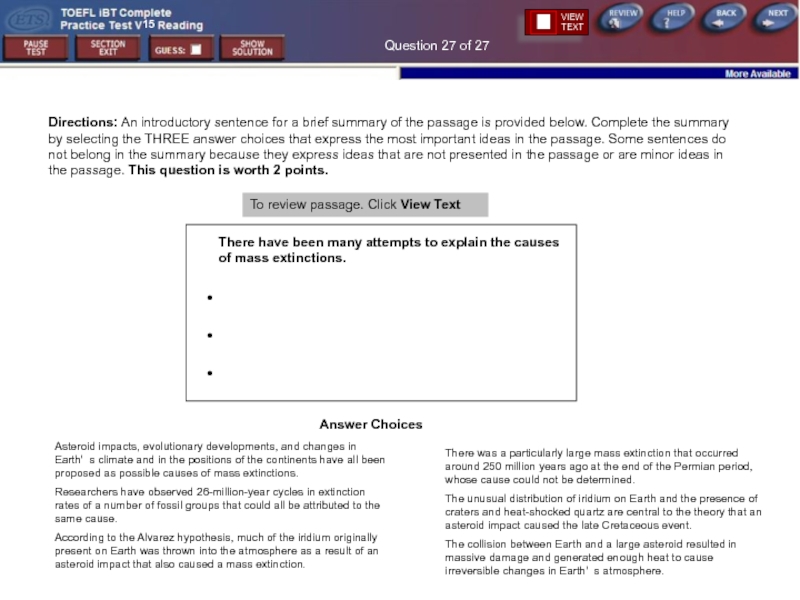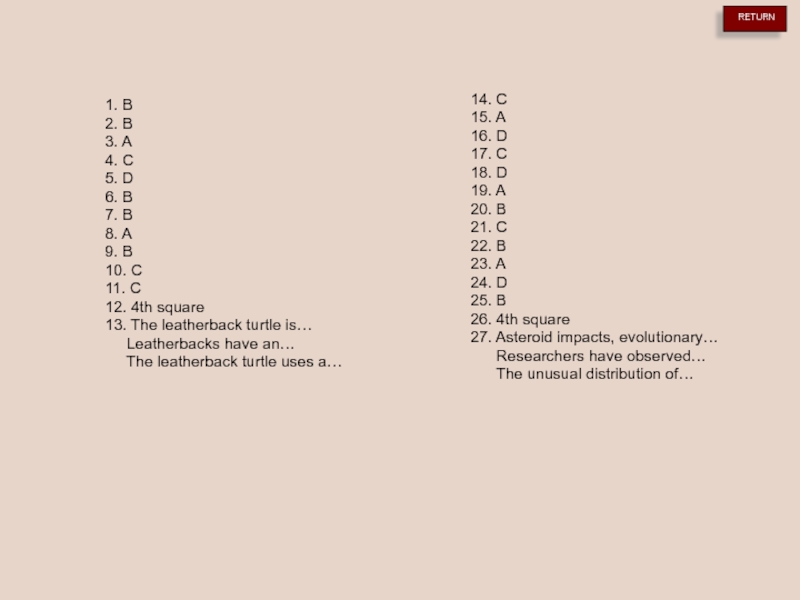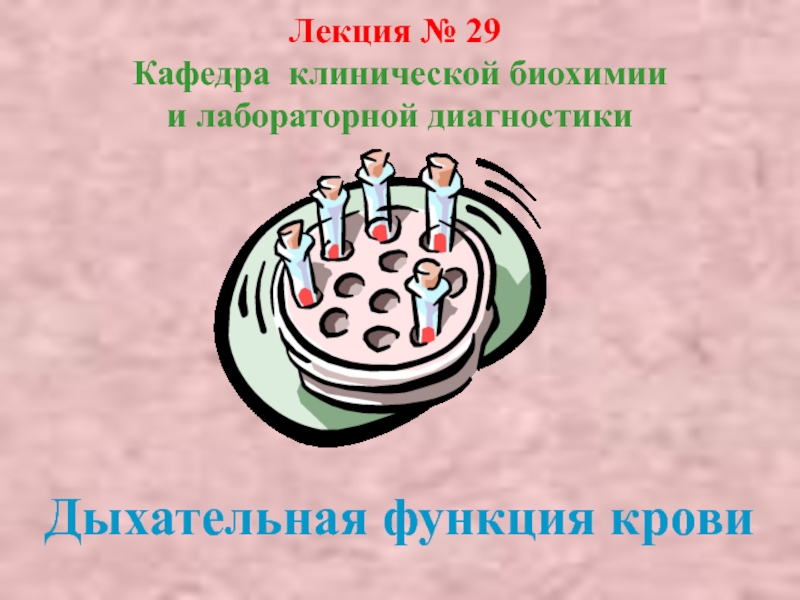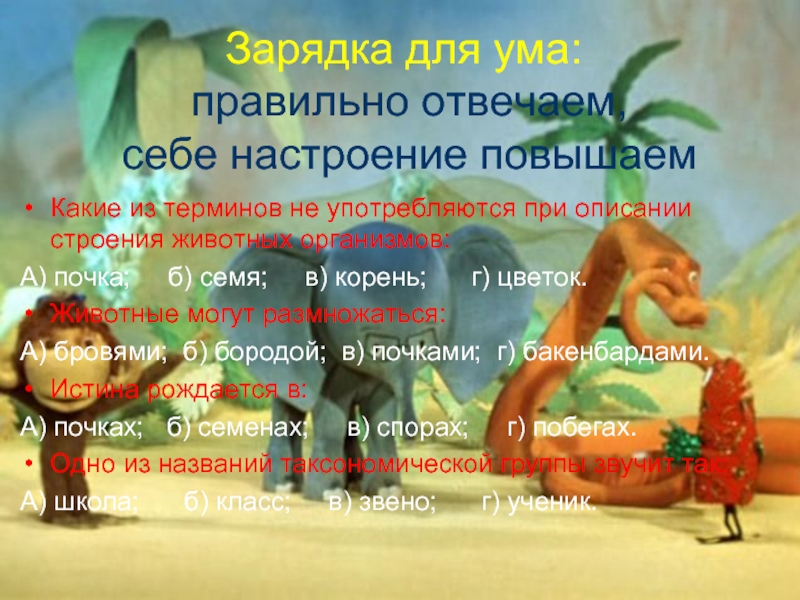- Главная
- Разное
- Дизайн
- Бизнес и предпринимательство
- Аналитика
- Образование
- Развлечения
- Красота и здоровье
- Финансы
- Государство
- Путешествия
- Спорт
- Недвижимость
- Армия
- Графика
- Культурология
- Еда и кулинария
- Лингвистика
- Английский язык
- Астрономия
- Алгебра
- Биология
- География
- Детские презентации
- Информатика
- История
- Литература
- Маркетинг
- Математика
- Медицина
- Менеджмент
- Музыка
- МХК
- Немецкий язык
- ОБЖ
- Обществознание
- Окружающий мир
- Педагогика
- Русский язык
- Технология
- Физика
- Философия
- Химия
- Шаблоны, картинки для презентаций
- Экология
- Экономика
- Юриспруденция
Test TPO 15. A warm-blooded turtle. (Section 2) презентация
Содержание
- 1. Test TPO 15. A warm-blooded turtle. (Section 2)
- 2. You can use the countdown timer at
- 3. Set the timer before doing
- 4. Question 1 of 27
- 5. Question 2 of
- 6. Question 3
- 7. Question 4
- 8. Question 5
- 9. Question 6
- 10. Question 7
- 11. Question 8
- 12. Question 9
- 13. Question 10
- 14. Question 11
- 15. Look at the four squares
- 16. Question 13
- 19. Paragraph 1
- 20. According
- 21. The
- 22. According
- 23. Paragraph
- 24. Which
- 25. According
- 26. The
- 27. Question
- 28. In
- 29. The
- 30. What
- 31. Look at the four squares
- 32. Directions:
- 34. Congratulations! You have completed this practice test.
- 35. 1. B 2. B 3. A
- 36. Are you sure you want to exit
- 37. Your answers will be saved with the
- 38. OK When your computer asks you if
- 39. OK When your computer asks you if
Слайд 2You can use the countdown timer at the left bottom corner
press this button to set the timer
pause countdown
Input a number
start countdown
Слайд 3
Set the timer before doing the test. Standard time for doing
If you cannot see the timer or if you cannot set the timer, you’ll need to install flash player. Click here to download and install adobe flash player.
Слайд 4
Question 1 of 27
The phrase 【unique among】 in the passage is
natural to
different from all other
quite common among
familiar to
Слайд 5
Question 2 of 27
What can be inferred about whales from paragraph
They are considered by some to be reptiles.
Their bodies are built in a way that helps them manage extremely cold temperatures
They are distantly related to leatherback turtles.
They can swim farther than leatherback turtles.
Paragraph 1 is marked with ◆
Слайд 6
Question 3 of 27
The word 【feat】 in the passage is closest
remarkable achievement
common transformation
daily activity
complex solution
Слайд 7
Question 4 of 27
Paragraph 2 mentions all of the following as
Their muscles produce heat for maintaining body temperature.
Their dark bodies help trap solar radiation.
Their cellular metabolism produces heat as a by-product.
Basking at the water‘s surface helps them obtain heat.
Paragraph 2 is marked with ◆
Слайд 8
Question 5 of 27
The word 【bulk】 in the passage is closest
strength
effort
activity
mass
Слайд 9
Question 6 of 27
The word 【it】 in paragraph 4 refers to
the
blood
the turtle
body temperature
Слайд 10
Question 7 of 27
According to paragraph 4, which of the following
An insulating layer of blubber
A thick, oily skin covering fatty tissue
The aerodynamic shape of its flippers
A well-insulated head
Paragraph 4 is marked with ◆
Слайд 11
Question 8 of 27
Which of the sentences below best expresses the
In a turtle's countercurrent exchange system, outgoing vessels lie near enough to ingoing ones that heat can be exchanged from the former to the latter before reaching the turtle' s flippers.
Within the turtle' s flippers, there is a countercurrent exchange system that allows colder blood vessels to absorb heat from nearby warmer blood vessels and then return warmed blood to the turtle's body.
In a countercurrent exchange system, a turtle can pick up body heat from being close enough to other turtles, thus raising its blood temperature as it passes them.
When a turtle places its flippers close to its body, it is able to use its countercurrent exchange system to transfer heat from the warmer blood vessels in its body to the cooler blood vessels in its flippers.
Слайд 12
Question 9 of 27
Why does the author mention 【old-fashioned steam radiator】
To argue that a turtle' s central heating system is not as highly evolved as that of other warmblooded animals
To provide a useful comparison with which to illustrate how a countercurrent exchange system works
To suggest that steam radiators were modeled after the sophisticated heating system of turtles
To establish the importance of the movement of water in countercurrent exchange systems
Слайд 13
Question 10 of 27
The phrase 【courses through】 in the passage is
rises through
heats up in
runs through
collects in
Слайд 14
Question 11 of 27
According to paragraph 6, which of the following
They lack the countercurrent exchange systems that develop in adulthood.
Their rate of growth is slower than that of other sea turtles.
They lose heat easily even with insulation and countercurrent exchange systems.
They switch between cold-blooded and warm-blooded modes throughout their hatchling stage.
Paragraph 6 is marked with ◆
Слайд 15
Look at the four squares [■]that indicate where the following sentence
However, these animals have additional means of staying warm.
Where would the sentence best fit?
■ 1
■ 2
■ 3
■ 4
Question 12 of 27
Слайд 16
Question 13 of 27
Directions: An introductory sentence for a brief summary
To review passage. Click View Text
Contrary to what we would expect of reptiles, the leatherback turtle is actually warm-blooded.
●
●
●
Answer Choices
The leatherback turtle is able to maintain body heat through sheer size.
Leatherbacks have an insulating layer that can be considered the reptilian version of blubber.
Young leatherbacks often do not survive to adulthood because they are not able to switch from a cold-blooded way of life to a warm-blooded one quickly enough.
Even though they swim into cold ocean waters, leatherbacks maintain their body heat in much the same way as sea turtles in warm southern oceans do.
The leatherback turtle uses a countercurrent exchange system in order to keep the flippers from drawing heat away from the rest of the body.
The shape of the leatherback turtle's flippers is especially important in maintaining heat in extremely cold northern waters.
Слайд 19
Paragraph 1 supports which of the following statements about mass extinctions?
They take place over a period of 70 million years.
They began during the Cretaceous period.
They eliminate many animal species that exist at the time they occur.
They occur every 250 million years.
Question 14 of 27
Paragraph 1 is marked with ◆
Слайд 20
According to paragraph 2, scientists base their belief that a mass
The speed with which mass extinctions are happening today is similar to the speed of past extinctions.
The number of species that have died out since the last extinction event is extremely large.
Mass extinctions occur with regularity and it is time for another one.
Fossil records of many marine species have disappeared.
Question 15 of 27
Paragraph 2 is marked with ◆
Слайд 21
The word 【extended】 in the passage is closest in meaning to
specific
unlimited
reasonable
long
Question 16 of 27
Слайд 22
According to paragraph 3, each of the following has been proposed
habitat destruction
continental movement
fierce interspecies competition
changes in Earth's temperature
Question 17 of 27
Paragraph 3 is marked with ◆
Слайд 23
Paragraph 3 supports which of the following ideas about mass extinctions?
Scientists
Mass extinctions are unlikely to happen again in the future.
Insects, flowering plants, and bottom-feeding predators in the oceans tend to be the first organisms to disappear during episodes of mass extinctions.
Some mass extinctions occurred on land and in the seas at the same time.
Question 18 of 27
Paragraph 3 is marked with ◆
Слайд 24
Which of the sentences below best expresses the essential information in
Based on their studies of extinction rates of numerous fossil groups, paleontologists David Raup and John Sepkoski have determined that mass extinctions occur about every 26 million years.
David Raup and John Sepkoski studied extinction rates of numerous fossil groups and suggest that mass extinctions during the Cretaceous period continued for 26 million years.
Studies that paleontologists David Raup and John Sepkoski conducted of various fossil groups have revealed that extinction rates have increased over the past 26 million years.
The studies conducted by paleontologists David Raup and John Sepkoski of the fossil remains of species suggest that the extinction rate of species started to increase by the middle of the Cretaceous period.
Question 19 of 27
Слайд 25
According to paragraph 4, what aspect of extinction episodes does the
Their location
Their frequency
Their duration
Their severity
Question 20 of 27
Paragraph 4 is marked with ◆
Слайд 26
The phrase 【account for】 in the passage is closest in meaning
describe
challenge
explain
test
Question 21 of 27
Слайд 27
Question 22 of 27
According to paragraph 6, what made iridium a
Its occurrence in a few locations on Earth against several locations on other planets
Its occurrence in limited quantities on Earth against its abundance in asteroids
Its ability to remain solid at extremely high temperatures
Its ease of detection even in very small amounts
Paragraph 6 is marked with ◆
Слайд 28
In stating that 【no asteroid itself has ever been recovered,】 the
The importance of the indirect evidence for a large asteroid
The fact that no evidence supports the asteroid-impact hypothesis
The reason many researchers reject the Alvarez hypothesis
The responsibility of scientists for not making the effort to discover the asteroid itself
Question 23 of 27
Слайд 29
The word 【intense】 in the passage is closest in meaning to
sudden
unusual
Immediate
extreme
Question 24 of 27
Слайд 30
What is the purpose of paragraph 7 in the passage?
It
It presents additional supporting evidence for the Alvarez hypothesis.
It explains why evidence relating to the Alvarez hypothesis is hard to find.
It shows how recent evidence has raised doubts about the Alvarez hypothesis
Question 25 of 27
Paragraph 7 is marked with ◆
Слайд 31
Look at the four squares [■]that indicate where the following sentence
In general, it is believed that these two extinctions resulted from drastic environmental changes that followed meteorite impacts or massive volcanic eruptions.
Where would the sentence best fit?
■ 1
■ 2
■ 3
■ 4
Question 26 of 27
Слайд 32
Directions: An introductory sentence for a brief summary of the passage
To review passage. Click View Text
There have been many attempts to explain the causes of mass extinctions.
●
●
●
Answer Choices
Asteroid impacts, evolutionary developments, and changes in Earth' s climate and in the positions of the continents have all been proposed as possible causes of mass extinctions.
Researchers have observed 26-million-year cycles in extinction rates of a number of fossil groups that could all be attributed to the same cause.
According to the Alvarez hypothesis, much of the iridium originally present on Earth was thrown into the atmosphere as a result of an asteroid impact that also caused a mass extinction.
There was a particularly large mass extinction that occurred around 250 million years ago at the end of the Permian period, whose cause could not be determined.
The unusual distribution of iridium on Earth and the presence of craters and heat-shocked quartz are central to the theory that an asteroid impact caused the late Cretaceous event.
The collision between Earth and a large asteroid resulted in massive damage and generated enough heat to cause irreversible changes in Earth' s atmosphere.
Question 27 of 27
Слайд 34Congratulations!
You have completed this practice test.
Save / exit the test
Review
Obtain answer keys
Слайд 35
1. B
2. B
3. A
4. C
5. D
6. B
7. B
8. A
9. B
10. C
11.
The leatherback turtle uses a…
14. C
15. A
16. D
17. C
18. D
19. A
20. B
21. C
22. B
23. A
24. D
25. B
26. 4th square
27. Asteroid impacts, evolutionary…
Researchers have observed…
The unusual distribution of…
Слайд 36Are you sure you want to exit the test?
YES
NO
Exit the test.
Return to the last question and resume doing the test.
Слайд 37Your answers will be saved with the file.
Your answers will
Do you want to save your answers?
YES
NO


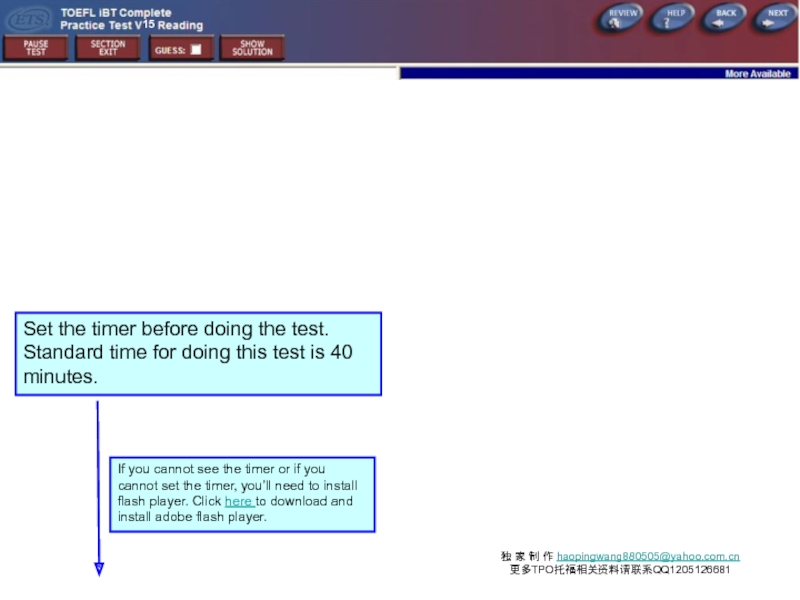
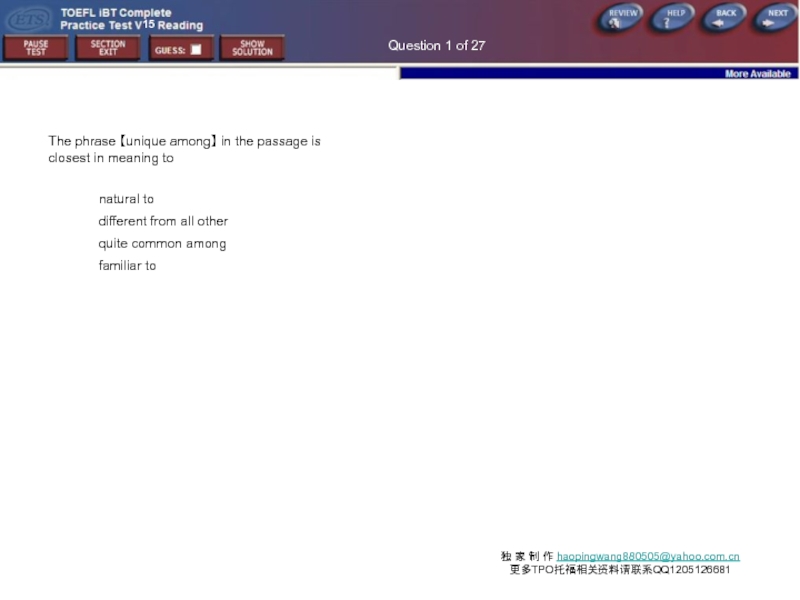
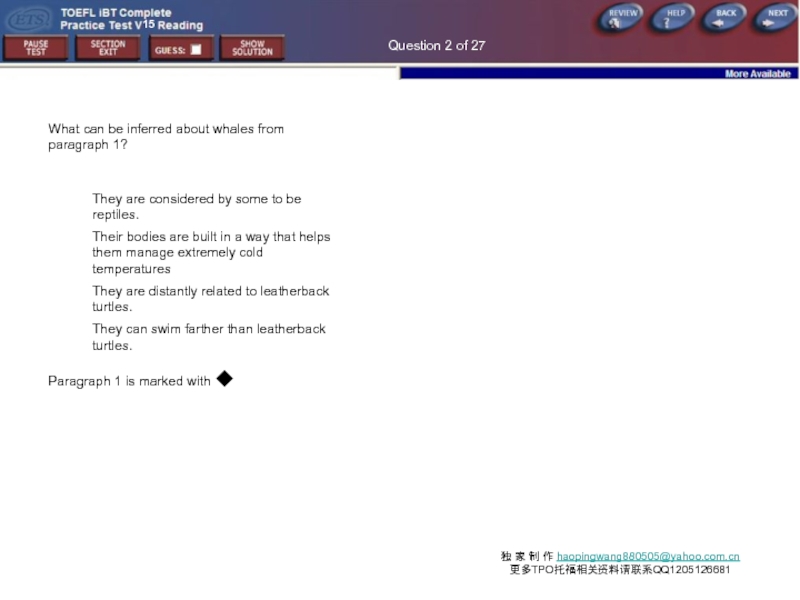
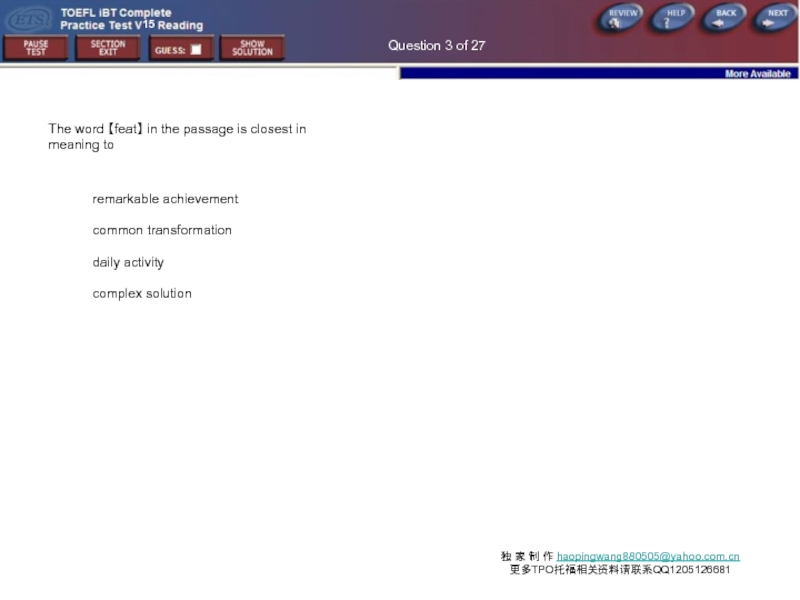
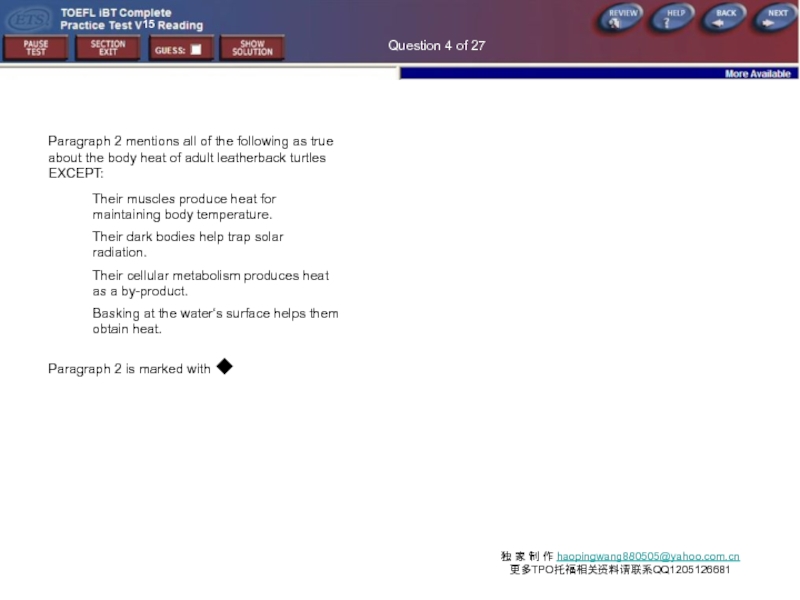
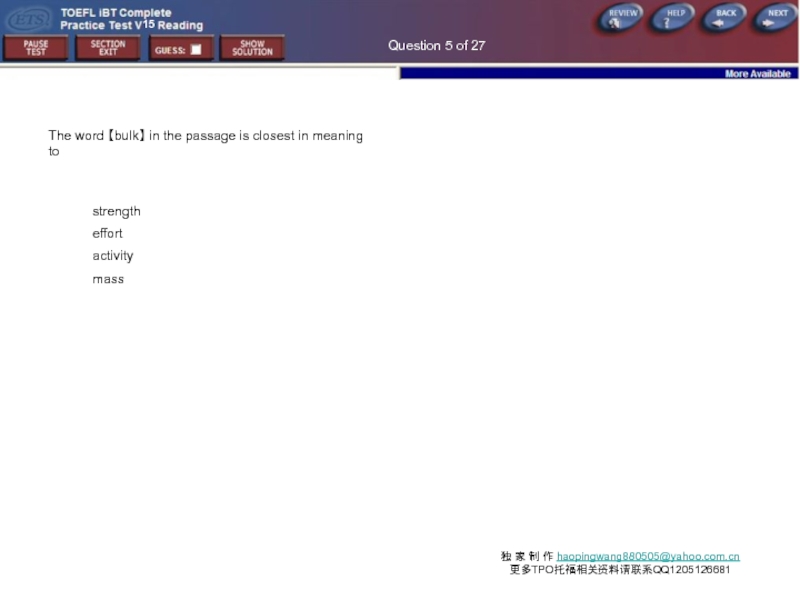
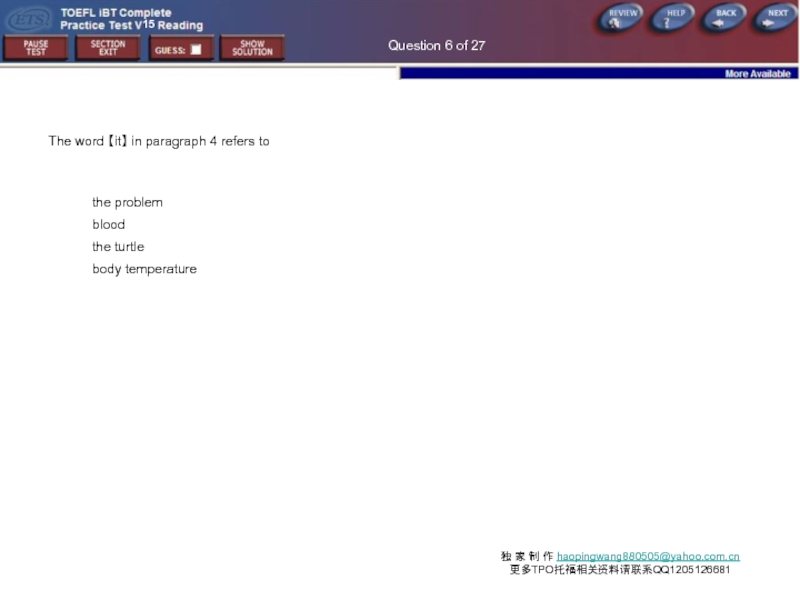
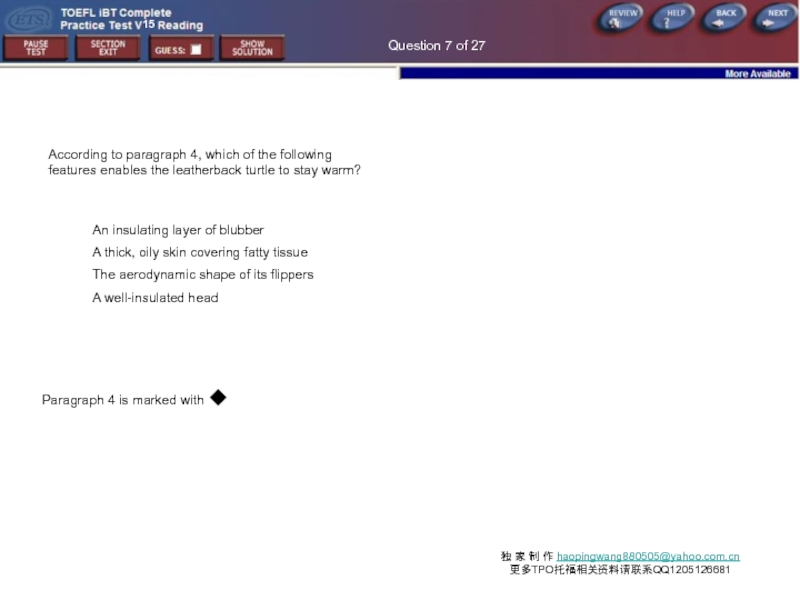
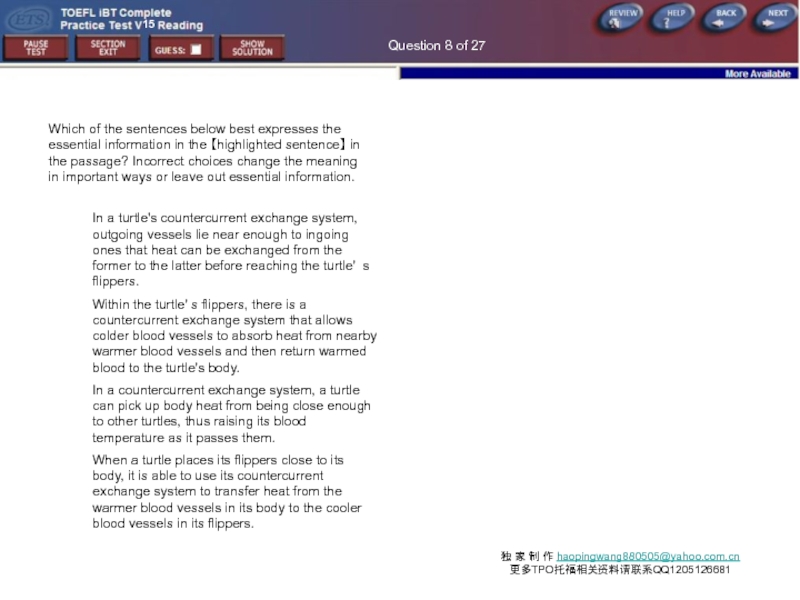
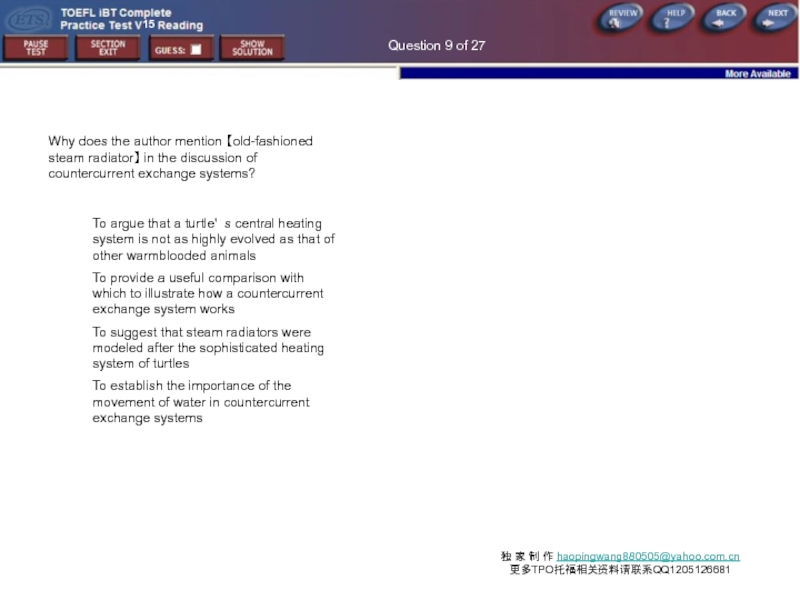

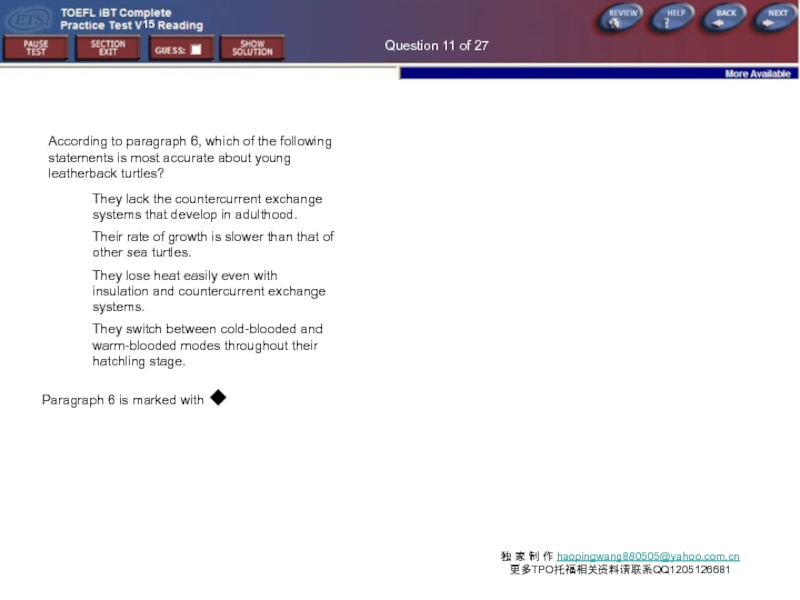
![Look at the four squares [■]that indicate where the following sentence could be added to](/img/tmb/4/323722/90e073c77d384892f848a3373fa106b8-800x.jpg)



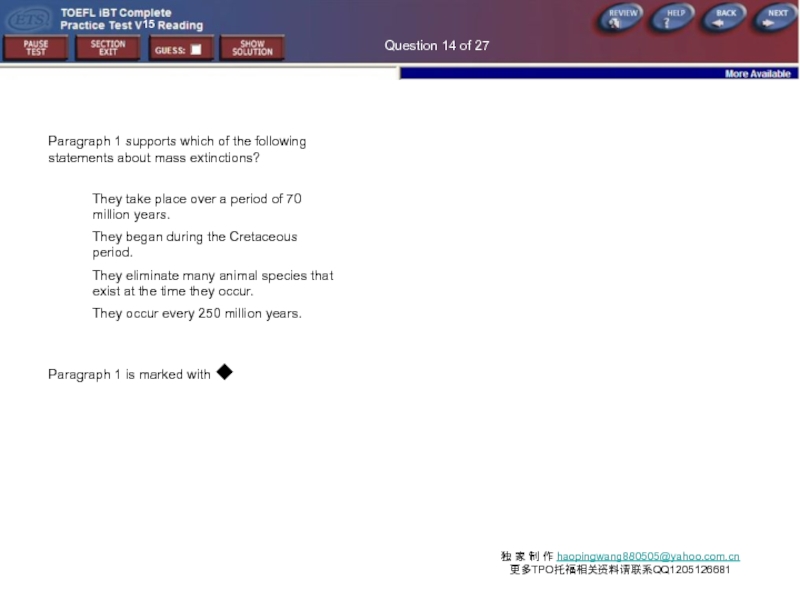
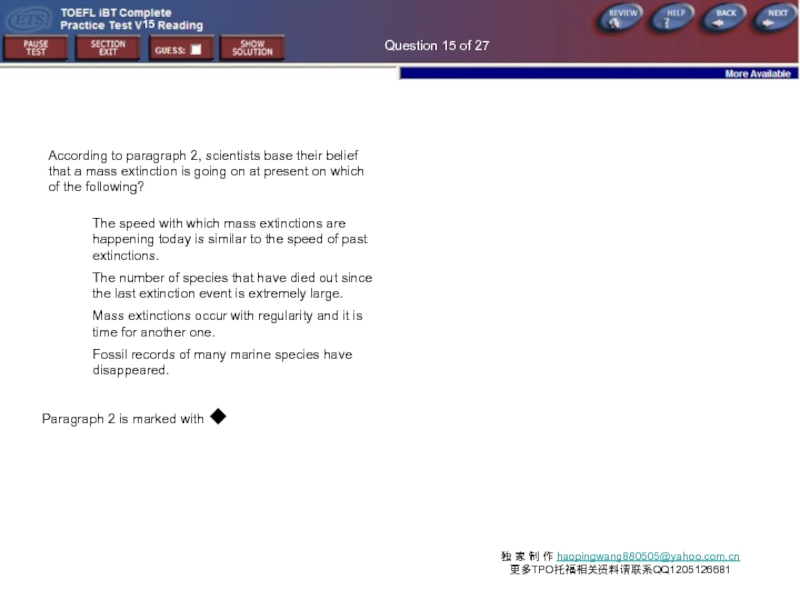
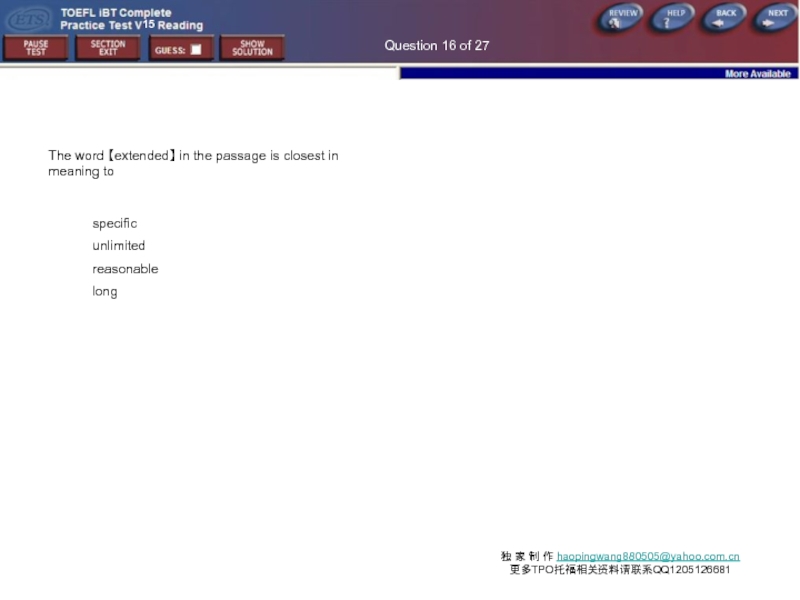
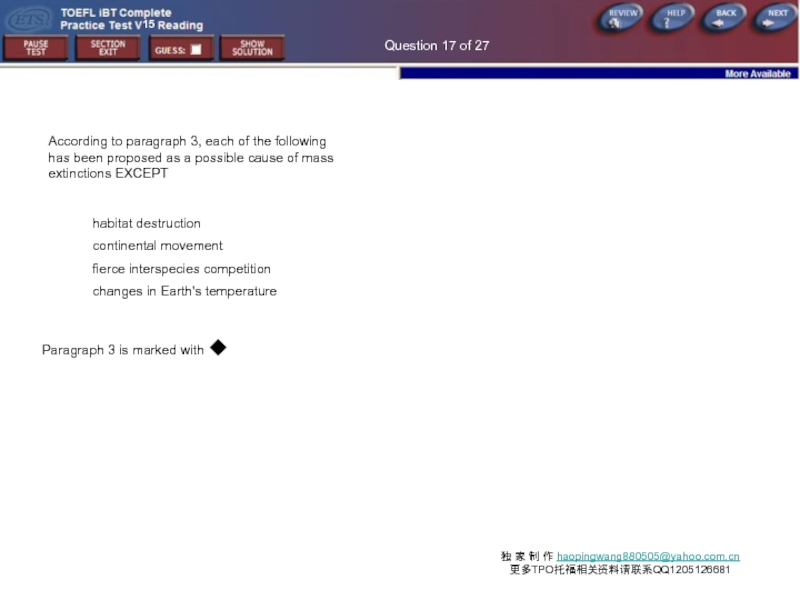
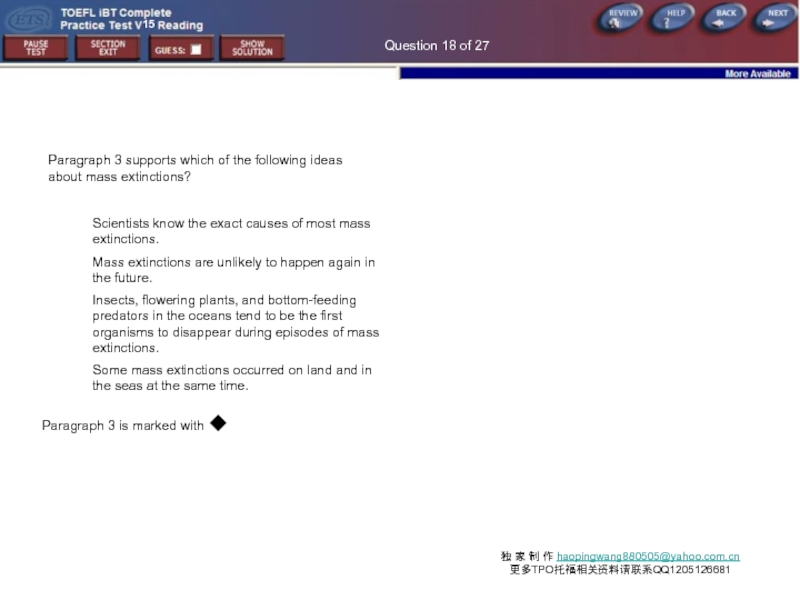
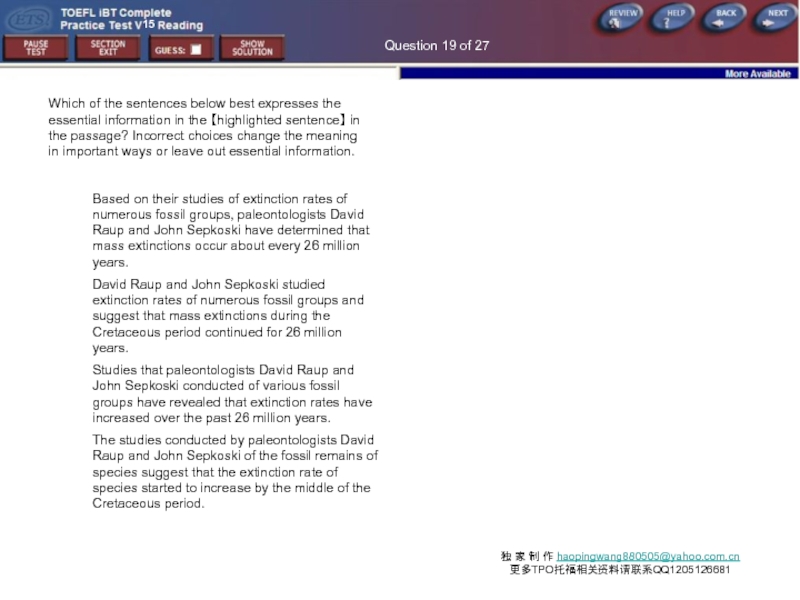
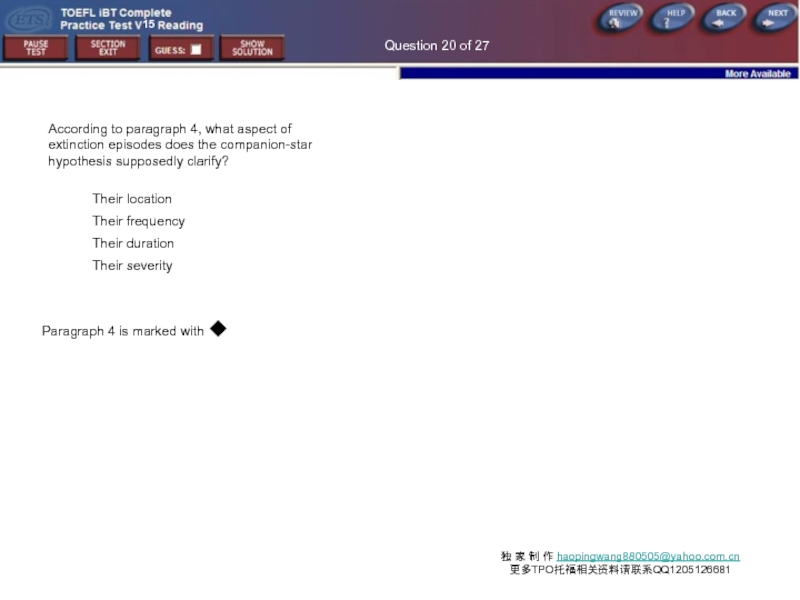
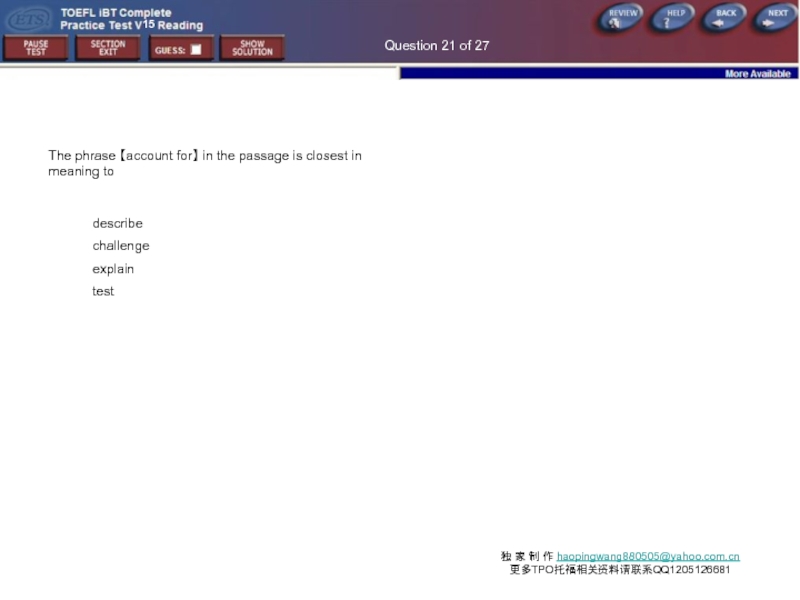
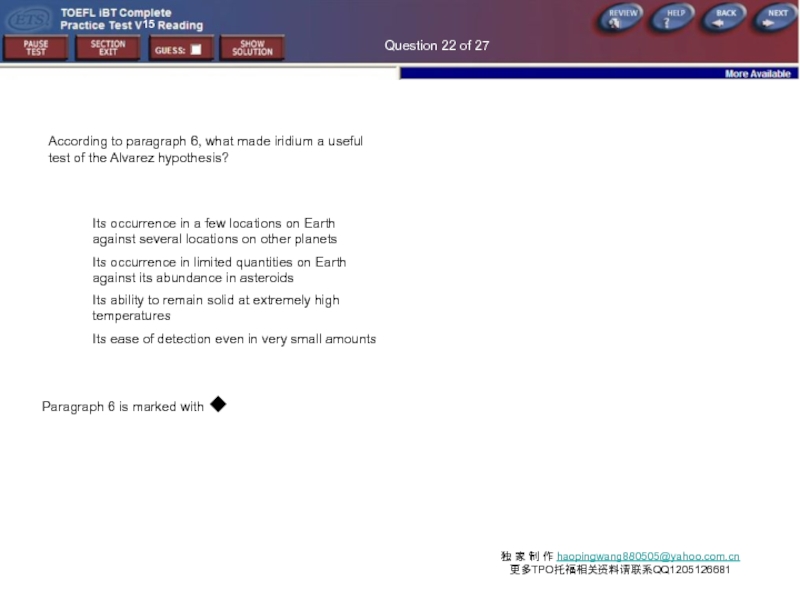
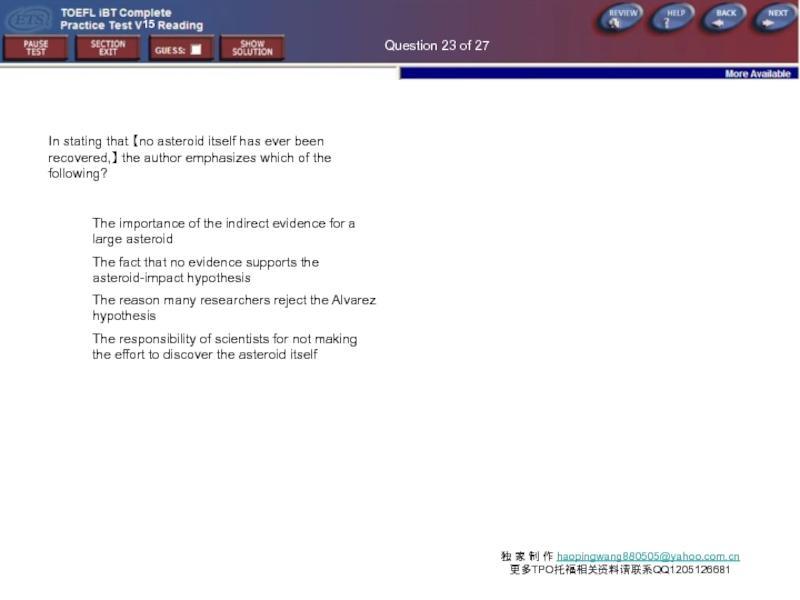

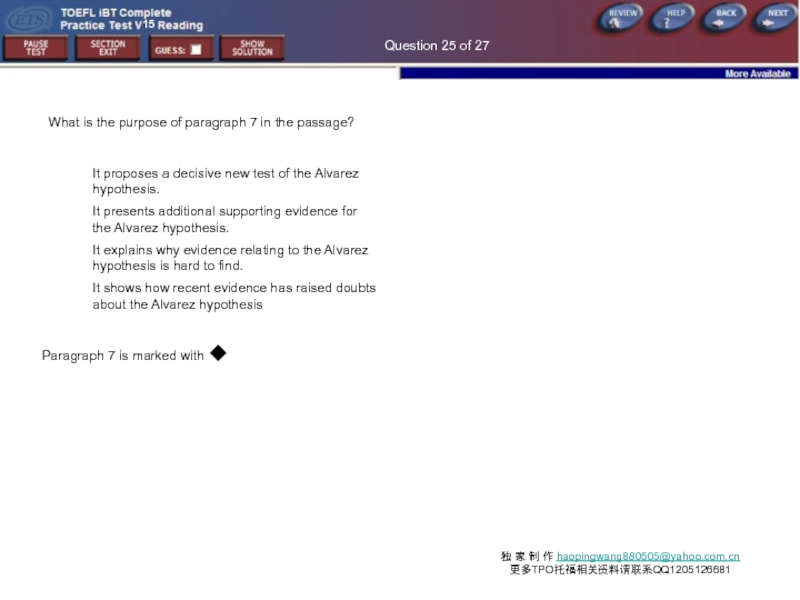
![Look at the four squares [■]that indicate where the following sentence could be added to](/img/tmb/4/323722/88dfe857a1797f7a2180bf0e0a8e0768-800x.jpg)
